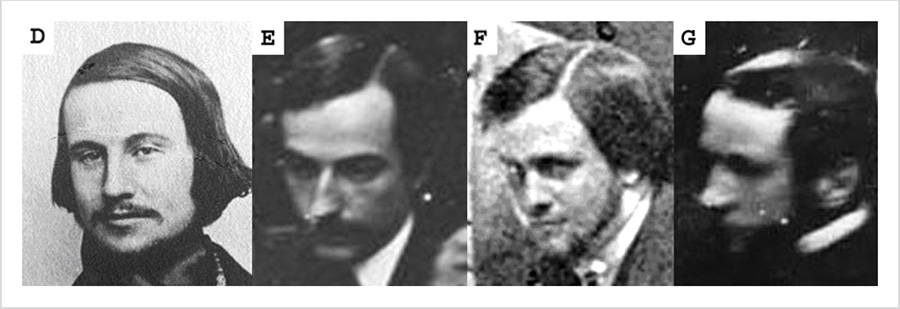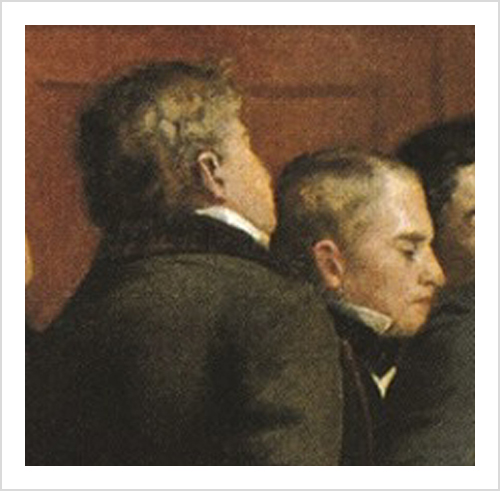

Comparative views of Henry Jacob Bigelow: D.) Portrait by Léon Foucault, 1841, age 23. E.) Figure 7 detail from EDD No. 1, identified by the author/artist as Samuel Parkman. Mistaken for Bigelow by historians. F.) The etherizer in EDD No. 5, reversed, age 29. G.) Figure 9 detail from EDD No. 1, age 28.
The seminal Abbott operation awakened the surgeons of Mass. General Hospital to the arrival of a new and potent muse of surgery and their role in its heralding. Foremost among these subalterns of the "enchanted goblet" was Dr. Henry Jacob Bigelow, who was instrumental in getting ether anesthesia instated at MGH (and reinstated after the Charles T. Jackson patent claim suspension). His historic paper on the Abbott operation preempted J. Collins Warren's own report, and proclaimed ether to the medical community worldwide.(39 »») For the widely held thesis of a reenactment scenario to be viable, it is essential that the presence of Bigelow be found within the frame of Ether Dome Daguerreotype No. 1.
To support the reenactment thesis, Lowry & Lowry identified Henry Jacob Bigelow in Figure 7, "The man with his hand grasping the chair."(40) But this is undocumented guesswork and even more tenuous than their identification of J. Collins Warren in Figure 8. Demonstrated by the panel shown here, the facial features of Figure 7 simply don't align with a splendid portrait of Bigelow, taken almost six years earlier by the brilliant young physicist Léon Foucault (1819-1868).(41 »») In 1841 Bigelow was a 23-yr-old medical student living in Paris when he befriended Foucault, who was Donné's research assistant in pioneering photomicrography. Paris was the cradle of photography in the 1840's and undoubtedly Bigelow acquired his knowledge of the camera from within the Donné circle, becoming an "expert photographer, untiring in the enigmatic perplexities of that art." (42 »») It was a skill he practiced extensively in both his personal and professional life and makes him a claimant to the commissioning of the Ether Dome daguerreotypes.
If Figure 7 isn't Bigelow, then could he be Figure 9? To further promote their version of the reenactment thesis, Lowry & Lowry proposed that Figure 9 was "probably" Ebenezer Hopkins Frost (1824-1866). Frost was Morton's first patient of record to undergo anesthesia and, at the behest of Morton, he was present for the Abbott operation. Rice described an expository role for Frost, there as a guarantor of Letheon for Morton, whether the anesthetic worked or not. But Rice omitted him from the center circle principals identified by his book, nor does Frost's visage appear in any of the Ether Dome daguerreotypes from what I can see.


Left image: portrait of Bigelow from Hall's engraving (reversed).
Right images: top–Hall's engraving, middle–Figure 9 from EDD No. 1, bottom–Wikipedia portrait, c1854.
Trace evidence strongly indicates that Bigelow is Figure 9, not 7. Elements of Hall's composition hew closely to EDD No. 1, and Figure 9 was his model for Bigelow, flipped by the printing process and nearly unchanged from the first and second states of the engraving. What I see in Hall's portrayal of Bigelow is a composite image of the Figure 9 profile in EDD No. 1 (head only), and the etherizer in EDD No. 5 (face only), and the cross-armed figure in EDD No. 3 (body only), which would establish that Hall had access to a copy of that daguerreotype as well.

Detail from Hinckley's painting of the Abbott operation. The right figure bears some resemblance to Bigelow's profile, but apparently Hinckley painted the left figure to represent him. Strangely, both Hinckley and Hall subordinated Bigelow in their representations of the Abbott operation, placing Parkman in a much more prominent light. It is bewildering why Hinckley painted Bigelow with his face turned away from the viewer, considering Bigelow's importance in the ether saga and the fact that painter and his subject were corresponding. Hall, of course, was mandated by Morton through Rice, but he was a highly respected professional and would not have swapped out the heads of the figures in EDD No. 1 arbitrarily.
To my eye, Bigelow is in all of the Ether Dome daguerreotypes: not only as Figure 9 in EDD No. 1, but also as the etherizer in EDD Nos. 2-5. The visage of the etherizer in EDD No. 5 is a clear and compelling match with Bigelow's student photo, and doesn't resemble the Lowry & Lowry or other legacy attributions that claim it is House-surgeon Charles Heywood who is applying the sponge for that surgery, discussed below. Heywood was only a factotum in the Ether Dome saga. Supporting documentation that Bigelow, not Heywood, is the etherizer in EDD Nos. 2-5 is found in Dr. J. Mason Warren's treatise on ether that continued his father's historic study on the physiological effects of ether for an additional nineteen cases up to March 24, 1847, comprising about ten that were private, and at least eight that were conducted at MGH. An excerpt for "Case XIII" reads, "Being rendered insensible by ether, which was administered in this, as in most of the other operations at the Hospital, [emphasis added] by Dr. H. J. Bigelow, the leg was removed at its middle by the circular operation."(43 »») This was the leg of Fanny Abbot [sic], Townsend's 42-yr-old female patient who went under the knife on January 2, 1847. "Case II," discussed above under the Mason Warren section, is the official record for when the sponge was found safe enough for etherizing a child, and subsequently replaced Morton's glass globe entirely in private practice and at Mass. General Hospital – March 6, 1847 according to his testimony.(44 »»). In the summation of his report, Warren noted the problems Morton's "inhaling apparatus" was causing:
|
"B. As to the Method to be employed. 1st. The use of the ordinary inhaling apparatus seemed in many cases to occasion at first irritation and choking. 2nd. This irritation either does not exist, or in a less degree, in cases where cloth or sponge has been used, which has been pretty extensively employed at the Hospital and in private practice by Dr. J. C. Warren and myself. 3rd. In many cases it is impossible, in consequence of the tender age of the patient, or his refractory nature, to make him comprehend the use of the ordinary apparatus, and here the cloth or sponge will be found of great service. 4th.-A quieting effect is produced even when ether is sprinkled upon the bed clothes, or a sponge moistened with it is laid upon the pillow; thus sometimes superseding the use of an opiate.(45 »») |
Additional trace evidence is inferred by the figure leaning into Bigelow in EDD Nos. 3 & 5 and who I am confident is his father Jacob Bigelow (1787-1879), demonstrated by the panel below. The hanging, low insertion of the columella in his father's nose skews the nostrils up and out, and gives a proboscis appearance to the tip of his nose – it is classic Bigelow and unmistakable! Historians remark on how very close the two were, and the elder Bigelow championed his son's efforts to introduce ether anesthesia at MGH. Jacob Bigelow was the first to break the astonishing news of etherization to London's medical community, which he communicated by a letter attached to a copy of his son's historic paper, addressed to his friend and former student, Francis Boott (1792-1863). Boott included an extract of Jacob Bigelow's letter along with the entirety of Henry's paper, published in the following January number of the Lancet.(46) The appearance of Jacob Bigelow in EDD Nos. 3 & 5 and not in EDD No. 4 casts doubt on the sequence of the photographs perpetrated by historians: EDD No. 4 was the first photograph taken of the operation and before his arrival in the amphitheater.

Four views of Jacob Bigelow: H.) New attribution. Detail of Jacob Bigelow, age 60, standing right of the etherizer in EDD No. 5, highly foreshortened. I.) Detail of portrait accessed through Wikipedia. J.) Detail pulled from the internet. K.) Detail of "Boston Doctors" daguerreotype by Southworth & Hawes (c1850), archived at the Metropolitan Museum of Art; Accession Number: 37.14.39.
A little over a year after his first report, Bigelow wrote a second, comprehensive report on the latest developments of ether anesthesia, published in the inaugural edition of the American Medical Association. His report was supplemented by a table of the 154 ether or chloroform surgeries conducted at MGH dating from the Abbott operation to March 31, 1848, and enumerated by columns for patient age, gender, operation, disease, and admittance & discharge dates.(47 »») Cross-checking Bigelow's tables with a search of the literature, turned up several surgeries that are compelling matches for the patient and the medical team portrayed in the "reenactment" daguerreotype. They will be discussed below.
Although EDD No. 1 is not a reenactment of the Abbott surgery, it does however capture the inauguration of the Junior Visiting-surgeons at Massachusetts General Hospital and their triumph of introducing ether anesthesia into the surgical armamentum. Considering the photograph is the model for Hall's engraving, it is easily misinterpreted as a reenactment of the Abbott operation. The identification of Parkman as Figure 7, discussed next, is conforming of the enactment scenario.
39.) Bigelow, HJ (1846), "Insensibility during Surgical Operations produced by Inhalation." Read before the Boston Society for Medical Improvement, Nov. 9th, 1846, etc. In: Boston Medical & Surgical Journal ; v. 35, no. 16 (Nov. 18), p. 309-317.
40.) Lowry & Lowry (2005); p. 79. "The man with his hand grasping the chair is Dr. Henry Jacob Bigelow, who had been the prime instigator of the original demonstration and the first to publish a report on the use of ether in surgery."
41.) Bigelow, WS, and Bigelow HJ (1900), "A Memoir of Henry Jacob Bigelow, A.M., M.D., LL.D." Boston: Little, Brown, and Company; the collotype of Bigelow faces page 18.
42.) Ibid (1900); p. 146.
43.) Warren, JM (1847); "Case XIII," p. 156-157. See also: Bigelow (1873), "Alleged death from ether. Letter to the editor of the British Medical Journal." In: British Medical Journal, vol. 2; p. 692: "It fell to my lot, in 1846, and for a year or two after the discovery of anaesthesia, as junior surgeon, to administer most of the ether in that institution[..]"
44.) Morton, WTG, et al (1853); p. 387.
45.) Warren, JM (1847); p. 160.
46.) Wolfe, RJ (1993); pp. 84, 158-159. Jacob Bigelow's letter to Francis Boott was dated November 28, 1846. See Boott, "Surgical operations performed during insensibility produced by the inhalation of sulphuric ether" ; in: [The London] Lancet, v. 1 (Jan. 2, 1847), 5-8.
47.) Bigelow, HJ (1848), "Anæsthetic agents, their mode of exhibition and physiological effects; with a list of patients who have inhaled ether or chloroform for surgical operations in the Massachusetts General Hospital, in the first surgical division of the New York Hospital, at the clinic of the University of Pennsylvania, and at the clinic of the Jefferson Medical College, [1847–8]." In: Transactions of the American Medical Association. Philadelphia: T. K. and P. G. Collins; vol. 1, p. 197-221. See columnar table C.-2. on pages 215-217. Reprint also issued.
